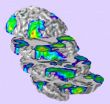(Press-News.org) Whale sharks (Rhincodon typus)—which grow more than 30 feet long—are the largest fish in the world's ocean, but little is known about their movements on a daily basis or over years. A newly discovered juvenile whale shark aggregation off Saudi Arabia is giving researchers a rare glimpse into the lives of these gentle giants.
Scientists from the Woods Hole Oceanographic Institution (WHOI) and colleagues from the King Abdullah University of Science and Technology (KAUST) and Massachusetts Division of Marine Fisheries report on the movements of whale sharks tagged at the site in a study published July 30, 2014, in the journal PLOS ONE.
During fieldwork in 2009, the research team found hundreds of juvenile whale sharks gathering on coral reefs near Al-Lith on the central coast of the Saudi Arabian Red Sea.
"The fact that there were so many whale sharks in such a small area gave us an opportunity to begin an unprecedented study to answer some of the basic questions," said Simon Thorrold, a biologist at WHOI and coauthor of the paper. "The discovery of the site provides a window into the movements and ecology of the species in a region that we were not necessarily expecting to see them in such high numbers."
The research team utilized three types of satellite transmitting tags to track the movements of 47 whale sharks from 2009 through 2011. The tags, which are placed just below the dorsal fins, measure temperature, depth, and light levels of the waters the fish swim in. After several months, the tags pop off, float to the surface and beam data via the ARGO satellite system back to computers on shore.
Diving data from the tags revealed the sharks made frequent deep dives to at least 500 meters (1,640 feet). Three of the tagged sharks made excursions below 1,000 meters (3,281 feet), with a maximum-recorded dive depth of 1,360 meters (4,462 feet).
Most of the sharks remained in the southern Red Sea throughout the time the tags were on. Some of the tagged individuals headed into the Indian Ocean, which may have been motivated by an abundant food supply related to seasonal upwelling. Whale shark diets vary both seasonally and geographically, but they are thought to feed mainly on zooplankton as well as algae, small fishes, fish eggs, and cephalopods.
"Interestingly, while some individuals that we tagged left the Red Sea and headed into the Indian Ocean, most remained relatively close to where they were tagged, suggesting that the area represents a critical juvenile habitat for this population," Thorrold added.
Adult whale sharks were not seen at the site, which may serve as a "staging ground" for juveniles before they move on to regional aggregations of larger sharks. To date, 12 whale shark aggregation sites have been identified globally.
"While all other juvenile whale shark aggregations are dominated by males, we found a sex ratio of 1:1 at the site in the Red Sea. The presence of so many female juvenile sharks may be of considerable significance to the global whale shark populations," Thorrold said.
Whale sharks were listed as "vulnerable" by the International Union for Conservation of Nature in 2000. Like other sharks and large rays, whale sharks likely have small litters of pups and are slow to reach sexual maturity.
The study highlights the need for more research on whale sharks as well as a multinational, cooperative effort to conserve populations in both the Red Sea and Indian Ocean.
"Our research on whale sharks in the Red Sea clearly shows that much remains to be learned about the species," said co-author Greg Skomal, a Massachusetts Division of Marine Fisheries biologist and WHOI adjunct scientist. "This newly discovered aggregation off Saudi Arabia likely plays an integral role in the natural history of this species in this region and, perhaps, well beyond."
"Eventually this work will tell us about where whales sharks are spending their time throughout their lives, where they're feeding, where they're breeding and where they're giving birth," added Thorrold. "Knowing where they go at different times of the year is critical to designing effective conservation strategies for the species."
INFORMATION:
Funding for this work was provided in part by KAUST baseline research funds and the U.S. National Science Foundation.
The Woods Hole Oceanographic Institution is a private, non-profit organization on Cape Cod, Mass., dedicated to marine research, engineering, and higher education. Established in 1930 on a recommendation from the National Academy of Sciences, its primary mission is to understand the ocean and its interaction with the Earth as a whole, and to communicate a basic understanding of the ocean's role in the changing global environment. For more information, please visit http://www.whoi.edu.
Newly discovered juvenile whale shark aggregation in Red Sea
Researchers get rare glimpse into the lives of ocean's gentle giants
2014-08-04
ELSE PRESS RELEASES FROM THIS DATE:
Horses communicate with their eyes and mobile ears
2014-08-04
Horses are sensitive to the facial expressions and attention of other horses, including the direction of the eyes and ears. The findings, reported in the Cell Press journal Current Biology on August 4, are a reminder for us humans to look beyond our own limitations and recognize that other species may communicate in ways that we can't, the researchers say. After all, human ears aren't mobile.
"Our study is the first to examine a potential cue to attention that humans do not have: the ears," says Jennifer Wathan of the University of Sussex. "Previous work investigating ...
Declining intelligence in old age linked to visual processing
2014-08-04
Researchers have uncovered one of the basic processes that may help to explain why some people's thinking skills decline in old age. Age-related declines in intelligence are strongly related to declines on a very simple task of visual perception speed, the researchers report in the Cell Press journal Current Biology on August 4.
The evidence comes from experiments in which researchers showed 600 healthy older people very brief flashes of one of two shapes on a screen and measured the time it took each of them to reliably tell one from the other. Participants repeated ...
Prenatal alcohol exposure alters development of brain function
2014-08-04
In the first study of its kind, Prapti Gautam, PhD, and colleagues from The Saban Research Institute of Children's Hospital Los Angeles found that children with fetal alcohol spectrum disorders (FASD) showed weaker brain activation during specific cognitive tasks than their unaffected counterparts. These novel findings suggest a possible neural mechanism for the persistent attention problems seen in individuals with FASD. The results of this study will be published in Cerebral Cortex on August 4.
"Functional magnetic resonance imaging (fMRI) has been used to observe ...
Mid-level scientists most likely to use new research tools, says study in INFORMS journal
2014-08-04
Scientists in the middle of the status hierarchy, not those at the top or the bottom, are the first to work with easy-to-use commercial products. They are also the most prone to imitate their prior collaborators' use of such commercial kits. These are among the findings of a study of scientists-as-customers appearing in Marketing Science, a journal of the Institute for Operations Research and the Management Sciences (INFORMS).
Nonmonotonic Status Effects in New Product Adoption is by Yansong Hu of the University of Warwick and Christophe Van den Bulte of the University ...
Animalistic descriptions of violent crimes increase punishment of perpetrators
2014-08-04
Describing criminals and criminal activities with animal metaphors leads to more retaliation against perpetrators by inducing the perception that they're likely to continue engaging in violence, a new Aggressive Behavior study suggests.
When surveying jury?eligible adults, investigators varied animalistic descriptions of a violent crime and examined its effect on the severity of the punishment for the act. Compared with non?animalistic descriptions, animalistic descriptions resulted in significantly harsher punishment for the perpetrator due to an increase in perceived ...
Evolutionary explanation for why some lessons more easily learned than others
2014-08-04
It's easy to guess why it doesn't take long to learn to avoid certain behaviors and embrace others. But how do we know what drives these predilections? A study led by Aimee Dunlap at the University of Missouri-St. Louis, and co-authored by University of Minnesota researcher David Stephens, offers insight into the evolutionary underpinning of animals' innate ability to quickly absorb critical life lessons.
Animals are flooded with stimuli, but survival often depends on their ability to form specific associations that enhance fitness while ignoring others entirely. Psychologists ...
Enhancing biofuel yields from biomass with novel new method
2014-08-04
RIVERSIDE, Calif. — A team of researchers, led by Professor Charles E. Wyman, at the University of California, Riverside's Bourns College of Engineering have developed a versatile, relatively non-toxic, and efficient way to convert raw agricultural and forestry residues and other plant matter, known as lignocellulosic biomass, into biofuels and chemicals.
The patent-pending method, called Co-solvent Enhanced Lignocellulosic Fractionation (CELF), brings researchers closer to solving the long elusive goal of producing fuels and chemicals from biomass at high enough yields ...
NASA catches the brief life of Tropical Storm Nakri
2014-08-04
The low pressure area known as System 96W struggled to organize for a week and finally became Tropical Storm Nakri on August 2 as the Suomi NPP satellite passed overhead. Nakri had a short life, however, as it dissipated the following day while approaching South Korea.
On Saturday, August 2, at 9 p.m. EDT, Nakri's maximum sustained winds were near 40 knots (46 mph/74 kph). At that time it was centered about 100 nautical miles southeast of Kunsan Air Base, near 35.0 north and 125.0 east. It was moving to the north at 14 knots (16.1 mph/21.9 kph).
When NASA-NOAA's Suomi ...
NASA sees Typhoon Halong's eye wink
2014-08-04
As Super Typhoon Halong tracks north through the Northwestern Pacific Ocean, NASA's Aqua and Terra satellites have seen the powerful storm appear to wink at space as it developed and "opened" an eye and then close its eye as clouds moved over it. That wink appears to be a sign of eyewall replacement in the powerful storm.
On August 2 at 01:45 UTC (August 1 at 9:45 p.m. EDT) NASA's Terra satellite captured a visible image of a wide-eyed Super Typhoon Halong moving through the Northwestern Pacific Ocean. At the time of the image, Halong was a powerful Category 5 Super Typhoon ...
No-power Wi-Fi connectivity could fuel internet of things reality
2014-08-04
Imagine a world in which your wristwatch or other wearable device communicates directly with your online profiles, storing information about your daily activities where you can best access it – all without requiring batteries. Or, battery-free sensors embedded around your home could track minute-by-minute temperature changes and send that information to your thermostat to help conserve energy.
This not-so-distant "Internet of Things" reality would extend connectivity to perhaps billions of devices. Sensors could be embedded in everyday objects to help monitor and track ...
LAST 30 PRESS RELEASES:
Numbers in our sights affect how we perceive space
SIMJ announces global collaborative book project in commemoration of its 75th anniversary
Air pollution exposure and birth weight
Obstructive sleep apnea risk and mental health conditions among older adults
How talking slows eye movements behind the wheel
The Ceramic Society of Japan’s Oxoate Ceramics Research Association launches new international book project
Heart-brain connection: international study reveals the role of the vagus nerve in keeping the heart young
Researchers identify Rb1 as a predictive biomarker for a new therapeutic strategy in some breast cancers
Survey reveals ethical gaps slowing AI adoption in pediatric surgery
Stimulant ADHD medications work differently than thought
AI overestimates how smart people are, according to HSE economists
HSE researchers create genome-wide map of quadruplexes
Scientists boost cell "powerhouses" to burn more calories
Automatic label checking: The missing step in making reliable medical AI
Low daily alcohol intake linked to 50% heightened mouth cancer risk in India
American Meteorological Society announces Rick Spinrad as 2026 President-Elect
Biomass-based carbon capture spotlighted in newly released global climate webinar recording
Illuminating invisible nano pollutants: advanced bioimaging tracks the full journey of emerging nanoscale contaminants in living systems
How does age affect recovery from spinal cord injury?
Novel AI tool offers prognosis for patients with head and neck cancer
Fathers’ microplastic exposure tied to their children’s metabolic problems
Research validates laboratory model for studying high-grade serous ovarian cancer
SIR 2026 delivers transformative breakthroughs in minimally invasive medicine to improve patient care
Stem Cell Reports most downloaded papers of 2025 highlight the breadth and impact of stem cell research
Oxford-led study estimates NHS spends around 3% of its primary and secondary care budget on the health impacts of heat and cold in England
A researcher’s long quest leads to a smart composite breakthrough
Urban wild bees act as “microbial sensors” of city health.
New study finds where you live affects recovery after a hip fracture
Forecasting the impact of fully automated vehicle adoption on US road traffic injuries
Alcohol-related hospitalizations from 2016 to 2022
[Press-News.org] Newly discovered juvenile whale shark aggregation in Red SeaResearchers get rare glimpse into the lives of ocean's gentle giants





